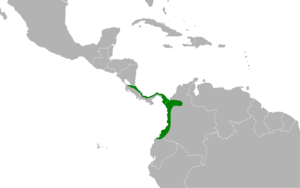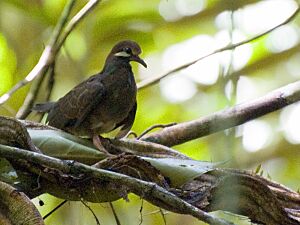Olive-backed quail-dove facts for kids
Quick facts for kids Olive-backed quail-dove |
|
|---|---|
 |
|
| Conservation status | |
| Scientific classification | |
| Genus: |
Leptotrygon
|
| Species: |
veraguensis
|
 |
|
| Synonyms | |
|
Geotrygon veraguensis |
|
The olive-backed quail-dove (Leptotrygon veraguensis) is a cool species of bird. It belongs to the Columbidae family, which includes doves and pigeons. You can find this bird living in parts of Colombia, Costa Rica, Ecuador, Nicaragua, and Panama.
Contents
Bird Families and Names
Scientists group living things into categories. This helps us understand them better. The olive-backed quail-dove used to be in a different group called Geotrygon. But in 2013, new research showed it belonged in its own special group, Leptotrygon. Big bird organizations like the American Ornithological Society agreed with this change. This bird is the only one in its special group!
|
|||||||||||||||||||||||||||
| Cladogram showing the position of genera in the tribe Zenaidini. |
What Does It Look Like?
Male olive-backed quail-doves are about 21 to 24.5 cm (8.3 to 9.6 in) long. Females are a bit smaller, around 21 to 22 cm (8.3 to 8.7 in) long. Both sexes weigh about 155 g (5.5 oz).
An adult bird has a white forehead that changes to a gray top of the head. The back of its head and neck are purple. It has a wide white stripe under its eye, with a thinner black stripe just below it. The upper parts of its body are dark olive brown or purplish brown.
Its throat is white, and its belly is white or a light tan color. The sides of its body are reddish-tan. The neck, chest, and upper parts of the bird can look shiny with green or purple colors. Males and females look very similar. Sometimes, a female might have a tan forehead. Young birds look similar too, but their feathers have rusty edges, and they don't have the shiny colors.
Where It Lives
The olive-backed quail-dove lives on the Caribbean side of southern Nicaragua, Costa Rica, and Panama. It also lives on the Pacific side of eastern Panama, through western Colombia, and into northern Ecuador.
This bird likes to live in thick, wet forests. It especially likes wet areas with small valleys or ravines. You can find it from sea level up to about 900 m (3,000 ft) high.
How It Behaves
Movement
The olive-backed quail-dove stays in its home range all year round. When it feels danger, it usually prefers to walk or run away. Sometimes, if it's really scared, it will fly short distances.
Feeding Habits
These birds usually look for food alone or in pairs. They search for food on the ground or in the plants close to the ground. Their diet includes seeds, fruits, and small invertebrates (like insects or worms).
Reproduction and Life Cycle
The olive-backed quail-dove's breeding season in Costa Rica is from January to July. Scientists have seen signs of breeding during these months in other areas too.
The bird builds a big nest using twigs and small roots. It usually places its nest in plants, about 1 to 2 m (3.3 to 6.6 ft) off the ground. A female bird typically lays two eggs at a time.
Bird Calls
The song of the olive-backed quail-dove is a low, short sound. It sounds like a single note, "whOuw," and some people say it sounds a bit like a frog!
Conservation Status
The IUCN (International Union for Conservation of Nature) has looked at the olive-backed quail-dove. They have assessed it as a species of "Least Concern." This means it's not currently in danger of disappearing. However, cutting down forests is a big problem for this bird. Losing its forest home definitely threatens this species.



